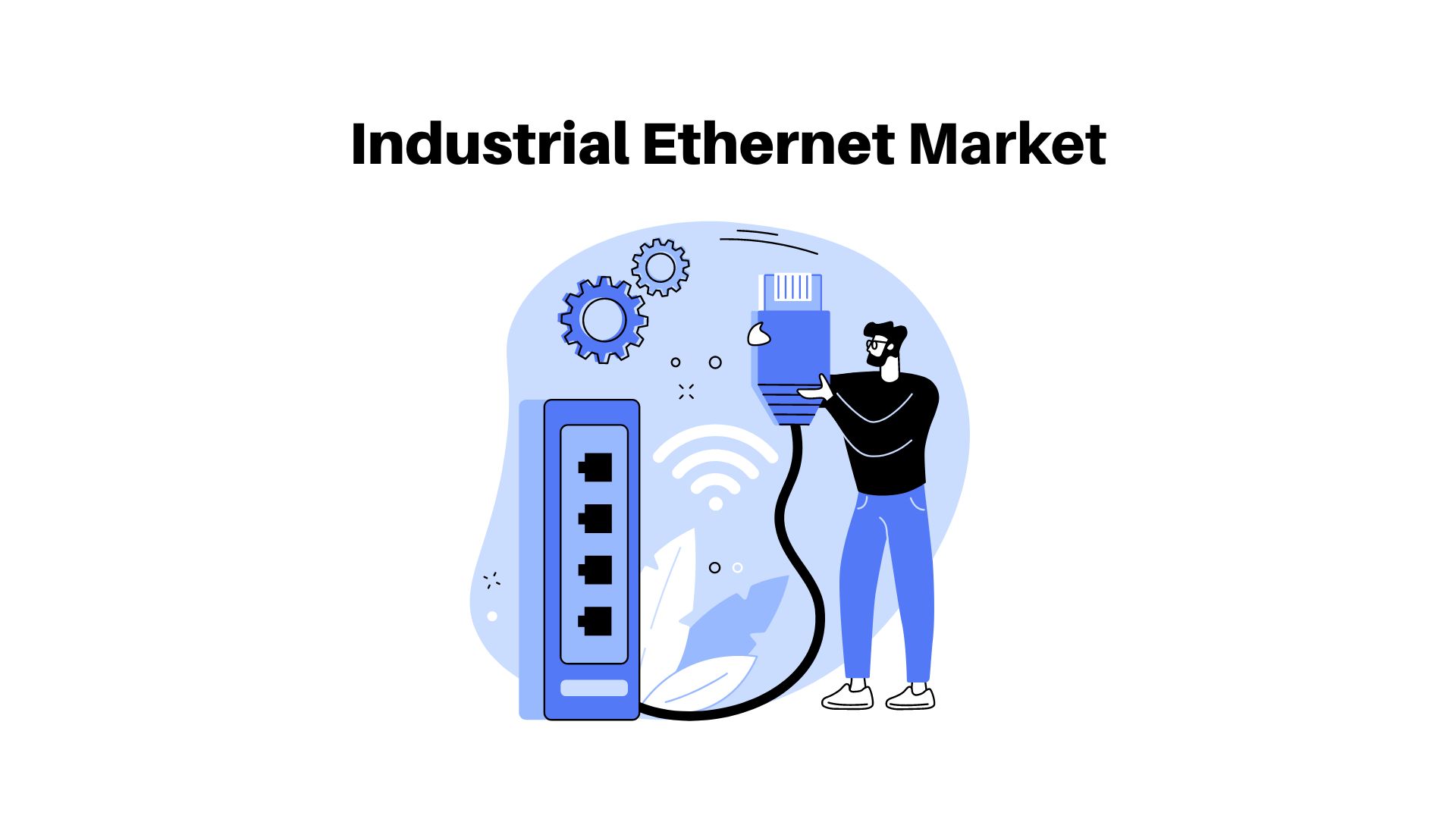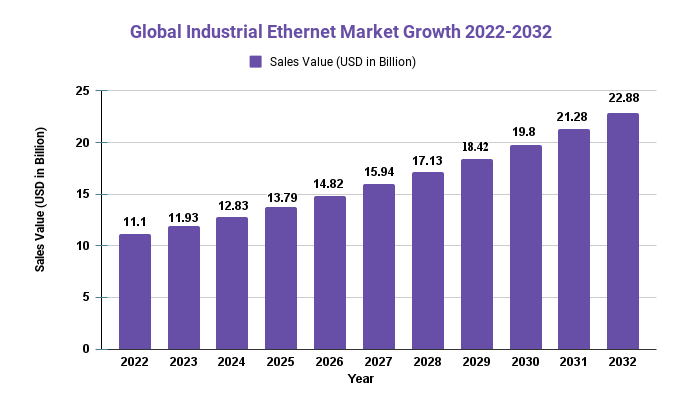Industrial Ethernet Market to Garner Bursting Revenues with CAGR rate of 7.5% 2022-2032

Page Contents
Industrial Ethernet Market Overview
Published Via 11Press: Industrial Ethernet refers to the application of Ethernet technology in industrial settings for communication between devices, machines, and systems. Industrial Ethernet is specifically designed for harsh conditions so it can withstand the rigors that industrial settings often present.
In recent years, the Industrial Ethernet market has grown rapidly due to rising demands for automation and connectivity in industrial processes. Furthermore, Industry 4.0 technologies such as the Industrial Internet of Things (IIoT) and cloud computing have further fuelled this expansion of this sector.
The global industrial ethernet market size is forecast to reach USD 22.88 billion by 2032 from USD 11.01 billion in 2022, rising at a compound annual growth rate (CAGR) of 7.5% during the forecast period.
The market is segmented based on components, protocol, application, and geography. Components such as switches, routers, and gateways, along with software drivers and protocols comprise the market share. Popular protocols include EtherCAT, EtherNet/IP, and PROFINET while applications range from automotive to energy & power to aerospace & defense sectors.
Geographically, the Industrial Ethernet market is dominated by North America and Europe, followed by Asia Pacific. Major players in this space include Siemens AG, Cisco Systems Inc., Rockwell Automation, Schneider Electric SE, and others.
The Industrial Ethernet market is expected to experience continued growth over the coming years, driven by an increasing need for automation and connectivity in industrial processes. Furthermore, advanced technologies such as 5G and edge computing will likely further fuel demand within this space. However, challenges such as high implementation costs and a shortage of skilled personnel could potentially hamper market expansion.

Key Takeaways
- Industrial Ethernet is the use of Ethernet technology in industrial settings for communication among devices, machines, and systems.
- The Industrial Ethernet market is expanding rapidly due to the rising need for automation and connectivity in industrial processes.
- The adoption of Industry 4.0 technologies such as the Industrial Internet of Things (IIoT) and cloud computing has further fuelled this market expansion.
- The market is segmented based on components, protocol, application, and geography.
- North America and Europe are the two primary regions within the Industrial Ethernet market, followed by Asia Pacific.
- The leading players in this market include Siemens AG, Cisco Systems Inc., Rockwell Automation, and Schneider Electric SE among others.
- The Industrial Ethernet market is expected to experience steady growth over the coming years, driven by an increasing need for automation and connectivity in industrial processes.
- However, challenges such as the high cost of implementation and lack of skilled professionals could hinder the expansion of this market.
Request For Sample Report: https://market.us/report/industrial-ethernet-market/request-sample/
Regional Snapshot
- North America: North America is the leading market for Industrial Ethernet, thanks to several prominent players in the region. The US is particularly influential when it comes to growth within this region.
- Europe: Europe is the second-largest market for Industrial Ethernet, driven by increased adoption of Industry 4.0 technologies across the region. Germany has been a major contributor to this growth.
- Asia Pacific: Asia Pacific is experiencing rapid growth in the Industrial Ethernet market, driven by an increasing need for automation and connectivity in industrial processes. China, Japan, and South Korea are leading this growth within the Asia Pacific.
- Middle East and Africa: The Industrial Ethernet market in the Middle East and Africa is being driven by an increase in the adoption of Industry 4.0 technologies across the region, particularly the UAE, Saudi Arabia, and South Africa. These countries are the major contributors to market growth within this region.
- Latin America: The Industrial Ethernet market in Latin America is expanding due to the increasing adoption of automation technologies across the region, especially in Brazil and Mexico. These countries are two major drivers behind this development.
Drivers
- Increasing Demand for Automation: The growing need for automation in industrial processes is driving the adoption of Industrial Ethernet technology. This facilitates seamless communication between machines and systems, improving productivity, efficiency, and safety.
- Industry 4.0: As Industry 4.0 technologies such as the Industrial Internet of Things (IIoT) and cloud computing become more commonplace, they are fuelling growth in the Industrial Ethernet market. Industrial Ethernet provides a secure communication platform for these emerging technologies to operate on.
- Harsh Environments: Industrial Ethernet is designed for use in harsh conditions, such as those found in manufacturing and oil and gas industries. This ruggedness is driving the adoption of Industrial Ethernet across these sectors due to its capacity for withstanding harsh conditions.
- Need for faster data transfer: Industrial Ethernet provides faster data transfer rates than traditional fieldbus systems, making it a more attractive option for industries with high-speed data needs.
- Standardization: The development of Ethernet-based industrial protocols like PROFINET and EtherNet/IP has contributed to the standardization of Industrial Ethernet, making it simpler to implement and integrate into existing systems.
Restraints
- High Cost of Implementation: Adopting Industrial Ethernet can be costly, particularly for small and medium-sized businesses. This may act as a deterrent to some firms, limiting the growth of the market.
- Limited Interoperability: Lack of compatibility between different Industrial Ethernet protocols and hardware can inhibit the adoption of this technology. Companies may hesitate to invest in a system that may not work with their current infrastructure.
- Need for Skilled Professionals: Implementing and maintaining Industrial Ethernet systems necessitate skilled personnel. Unfortunately, the shortage of qualified personnel in certain regions can pose a barrier to market expansion.
- Security Concerns: Industrial Ethernet systems can be vulnerable to cyber-attacks, which could result in extensive damage to industrial processes. This may serve as a deterrent for companies considering adopting Industrial Ethernet.
- The complexity of Implementation: Adopting Industrial Ethernet can be a challenging undertaking for companies with limited resources or expertise. A thorough understanding of the technology and its application are necessary in order to successfully implement it.
Opportunities
- Increasing Demand for Wireless Industrial Ethernet: The growing adoption of wireless Industrial Ethernet can present new market opportunities. Wireless Industrial Ethernet offers greater mobility and flexibility in industrial processes, as well as real-time data communication capabilities.
- Integration with Edge Computing: Combining Industrial Ethernet with edge computing can open up new market prospects. Edge computing brings data processing closer to its source, decreasing latency and optimizing industrial processes.
- Expansion in Emerging Economies: The expansion of Industrial Ethernet into emerging economies such as India and China offers new growth prospects for the market. The increasing adoption of automation and Industry 4.0 technologies in these regions are expected to fuel demand for Industrial Ethernet services.
- Industrial Ethernet Adoption Driven by Demand for Real-Time Data: As industrial processes increasingly require real-time data, Industrial Ethernet provides faster and more dependable data communication that enables real-time monitoring and control of production processes.
- Integration with Artificial Intelligence (AI) and Machine Learning (ML): Combining Industrial Ethernet with AI and ML can open up new prospects for the market. AI/ML integration can enable predictive maintenance, and autonomous decision-making in industrial processes, improving efficiency and productivity at the same time.
Challenges
- Standardization: Although standardization has promoted Industrial Ethernet adoption, there remain numerous different protocols and hardware options available which could cause interoperability issues.
- Cybersecurity: As more industrial processes are linked to the internet, there is an elevated risk for cyber-attacks. Industrial Ethernet systems may be particularly vulnerable to these assaults and companies must ensure their systems remain secure.
- Interference: Industrial Ethernet operates on a shared network, which may lead to interference and reduce the reliability of communication links.
- Integration with Legacy Systems: Many companies may already have existing legacy systems that may not be compatible with Industrial Ethernet. This presents integration challenges and may necessitate investing in additional hardware or software to make the systems compatible.
- Maintenance and Repair: Industrial Ethernet systems require complex maintenance and repair, necessitating skilled professionals to diagnose and resolve any issues.
Grow your profit margin with Market.us Get this Report
Recent Developments
- Expansion of 5G-Based Industrial Ethernet: Industrial Ethernet providers are now expanding their offerings to include 5G-based systems, providing faster and more dependable communication in industrial processes.
- Introduction of TSN-Enabled Industrial Ethernet: Time Sensitive Networking (TSN) is an Ethernet-based protocol that enables precise and deterministic communication in industrial processes. Many Industrial Ethernet providers have adopted TSN-capable systems to meet the demand for more dependable, efficient networks.
- Development of Edge Computing-Enabled Industrial Ethernet: Edge computing brings data processing closer to its source, decreasing latency and optimizing industrial processes. Industrial Ethernet providers are responding by developing edge computing-enabled systems in response to demands for faster and more dependable data communication systems.
- Collaboration Between Industrial Ethernet Providers and IT Companies: Industrial Ethernet providers are joining forces with IT firms to develop integrated solutions that seamlessly combine Industrial Ethernet with cloud computing, artificial intelligence, and machine learning.
- Adoption of Wireless Industrial Ethernet: Wireless Industrial Ethernet adoption is on the rise, driven by a need for greater mobility and flexibility in industrial processes. Industrial Ethernet providers are expanding their offerings to include wireless systems that can withstand harsh industrial conditions.
Key Market Segments
Type
- Ethemet/IP
- PROFINET
- EtherCAT
- Mobbus TCP/IP
- POWERLINK
Application
- Electric Power
- Transportation
- Oil & Gas
Key Market Players
- Belden
- Siemens
- Moxa
- Phoenix Contact
- Red Lion Controls
- Cisco
- Schneider Electric
- Rockwell Automation
- Beckhoff automation
- Westermo
- Kyland
- WAGO Corporation
- Advantech
- Transcend
Nature Insights
The Industrial Ethernet market is growing rapidly due to the rising adoption of Industry 4.0 technologies and the demand for more efficient and connected industrial processes. This market features fierce competition among vendors, with several established players as well as new entrants competing for market share.
One of the primary drivers of Industrial Ethernet market growth is the need for faster and more dependable data communication in industrial processes. Industrial Ethernet allows real-time monitoring and control of processes, improving efficiency and productivity. Wireless Industrial Ethernet adoption as well as integration with edge computing, AI, and ML are other key trends fueling growth in this space.
However, the Industrial Ethernet market is not without its challenges. Standardization and cybersecurity are two primary concerns facing this sector as interoperability issues and cybersecurity risks could hinder adoption. Furthermore, integration of Industrial Ethernet with legacy systems as well as maintenance and repair of these systems are complex tasks requiring skilled personnel.
Overall, the Industrial Ethernet market is expected to experience significant growth over the coming years as companies increasingly adopt Industry 4.0 technologies and strive to enhance their industrial processes. We can expect the market to keep evolving with new technologies and solutions tailored toward industrial customers' needs.
Report Scope
| Report Attribute | Details |
| The market size value in 2022 | USD 11.01 Bn |
| Revenue forecast by 2032 | USD 22.88 Bn |
| Growth Rate | CAGR Of 7.5% |
| Regions Covered | North America, Europe, Asia Pacific, Latin America, and Middle East & Africa, and the Rest of the World |
| Historical Years | 2017-2022 |
| Base Year | 2022 |
| Estimated Year | 2023 |
| Short-Term Projection Year | 2028 |
| Long-Term Projected Year | 2032 |
Contact us
Contact Person: Mr. Lawrence John
Market.us (Powered By Prudour Pvt. Ltd.)
Tel: +1 718 618 4351
Send Email: [email protected]
FAQ.
Industrial Ethernet is a type of communication network used to link industrial equipment and devices together, enabling real-time monitoring and control over industrial processes. It's designed for use in harsh industrial conditions while supporting high-speed data transmission.
The key drivers of growth in this space include the increasing adoption of Industry 4.0 technologies, the need for more efficient and connected industrial processes, as well as an urgent need for faster data communication.
The primary issues confronting this sector include standardization, cybersecurity, interference, integration with legacy systems, and maintenance & repair.
Recent advancements include 5G-enabled Industrial Ethernet, edge computing systems, a collaboration between Industrial Ethernet providers and IT companies, as well as increasing adoption of wireless Industrial Ethernet.
The Industrial Ethernet market is expected to experience significant growth over the coming years as more companies adopt Industry 4.0 technologies and strive to boost efficiency and productivity in their industrial processes. Nonetheless, challenges such as standardization, cybersecurity, and interoperability remain present within this landscape.
The team behind market.us, marketresearch.biz, market.biz and more. Our purpose is to keep our customers ahead of the game with regard to the markets. They may fluctuate up or down, but we will help you to stay ahead of the curve in these market fluctuations. Our consistent growth and ability to deliver in-depth analyses and market insight has engaged genuine market players. They have faith in us to offer the data and information they require to make balanced and decisive marketing decisions.



